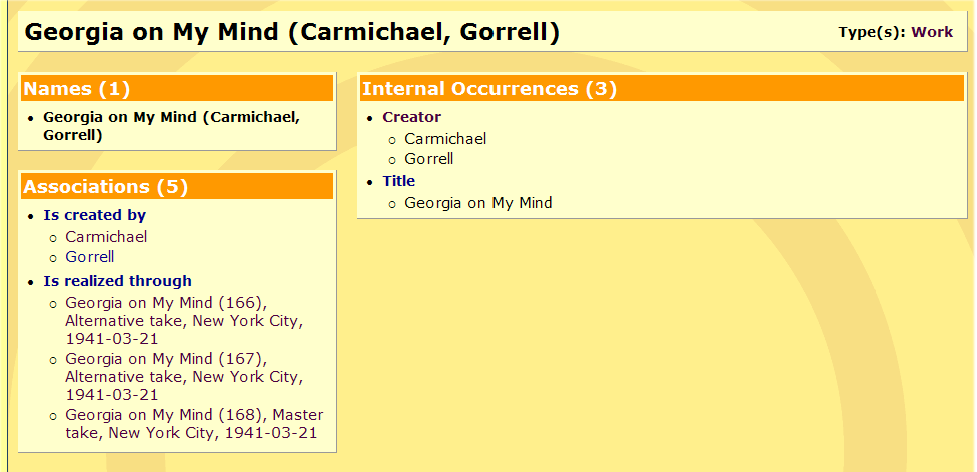- /documents/topic_maps_and_catalogues_of_museums_libraries_and_archives

Topic Maps and Catalogues of Museums, Libraries and Archives
Published by {{by}} on {{at}} and updated at {{updated}}.
Abstract:
This case study is about the usage of Topic Maps for catalogues of Museums, Libraries and Archives. The first part describes two projects using Topic Maps by implementing data with the FRBR-model. The second part of the study concentrates on another two projects that uses the Topic Map paradigm to integrate several catalogues.
There have been some initiatives or exploration of the potential uses of Topic Maps to Integrated Library Systems (ILS) or catalogues in the MLA institutions. However, most of them are prototypes and not implemented due to the fact that no vendor in the MLA field has already incorporated Topic Maps to their systems yet. Those projects that are online proved their skills, some were/are still prototypes and others are not meant for a public usage. The following case study is going to show examples of Topic Maps based projects especially for catalogues of museums, libraries or archives. The first part describes two projects using Topic Maps by implementing data with the FRBR-model. The second part of the study concentrates on another two projects that uses the Topic Map paradigm to integrate several catalogues.
About FRBRization of library catalogues and two projects using that model
Functional Requirements for Bibliographic Records (FRBR) is an entity-relationship model proposed by the International Federation of Library Associations and Institutions (IFLA) in 1998. It describes the conceptual model of the bibliographic world. It is intended to present a model of the bibliographic universe cataloging and records, independent of any format or specific implementation. It is considered by the LIS community as the way to follow in structuring library systems. The process of implementing FRBR in actual catalogues has been called FRBRization.
The most common way to do this FRBRization is to use the MARC bibliographic records, convert them into FRBR (for example using the algorithm released by OCLC), and then formalize the FRBRized MARC into an ontology, e.g. using Topic Maps or W3C OWL.
In the following, two projects are presented that report to have used Topic Maps for this purpose. Both are still in the status of prototypes.
The Catalogue of the Digital National Library of Korea
This project is a prototype using a topic map to FRBRize its catalogue and was developed for the National Digital Library of Korea. This solution consisted of using an algorithm (created by OCLC) to convert the MARC records to the FRBR model, and a topic map to actually FRBRize the catalogue. Even today it appears to be the most complete representation and implementation of FRBR in Topic Maps. It includes the three FRBR Groups, their entities, attributes and associations.
Current status: prototype in study for implementation (2008)
Bibliography:
Oh, S. G. (2008). MARC, FRBR and RDA: The Topic Maps Perspective. Presentation given at the International Topic Maps Users Conference in Oslo.
Oh, S. G. (2008). Topic Maps in Library Science (tutorial: Topic Maps for Library and Information Scientists). Presentation given at the International Topic Maps Users Conference in Oslo.
Oh, S. G. (2007). Topic Maps-Driven Semantic Services for National Library of Korea. Presentation given at the Asian Topic Maps Summit 2007 Kyoto, Japan.
A topic map for music information
In this Norwegian project FRBR was used as an ontology for a topic map in developing a prototype on music information. The main topic types were ‘Expression’, ‘Manifestation’, ‘Person’, and ‘Work’; the main association types were ‘Creation’, ‘Embodiment’, and ‘Realization’.
 Example of displaying “Work” information in a topic map. (Aalberg, 2005).
Example of displaying “Work” information in a topic map. (Aalberg, 2005).
This application was intended to serve as a model for the “BIBSYS FRBR project”, which consisted in a research on the use and implementation of FRBR to library catalogues, specifically at the Norwegian library system (BIBSYS). The participants of this research included the Norwegian University of Science and Technology (NTNU), the National Library of Norway, The National Database Project of Norwegian University Museums (CRM), and OCLC (Online Computer Library Center, Inc.).
Current status: Prototype
Bibliography:
Aalberg, T. (2005). Formats and FRBR Catalogues – Where’s our focus? Presented at FRBR in 21st Century Catalogues: An Invitational Workshop, OCLC. United States.
Integration of library catalogues
The usage of Topic Maps in the Humanities is of great interest. Reasons for this are the partly heterogeneous catalogue data like texts, pictures or even musical works. By integrating these data with the Topic Maps standard the data can be better organized and displayed.
Two integral aims of integrating library catalogues by using Topic Maps is to simplify user-sided search processes and to optimize the structuring and developing of the catalogues data containing in the specific catalogues. The two projects that are described below shows how the Topic Maps model can be used to integrate several catalogues of the same library.
Prototype for the Danmarks Kunstbiblioteks katalog
The Danish Art Library tested a Topic Maps-based system prototype for the integration of five different search databases. The topic map facilitated their browsing and was suitable to deal with different vocabularies of specific domains in the Humanities. One of the main reasons to choose Topic Maps for this prototype was that it is a relatively simple and cheap technology with high flexibility, both in integration with other technologies and in its constant development.
Current status: Prototype
Bibliography:
Bøckman, K. A. (2006). Topic Maps som browsemodel for humanistiske bibliotekers informationsformidling: Med særligt henblik på humanisters emnevokabular: En case-undersøgelse af Danmarks Kunstbibliotek. Bachelor’s thesis, Danmarks Biblioteksskole.
Bøckman, Knut Anton. (2007). Browsing i bibliotekskataloger ved hjælp af Topic Maps. Dansk Biblioteksforskning 3 (2), 33-44.
The Royal Library catalogue
Another Danish topic map prototype was tested at The Royal Library in Copenhagen to integrate three of its more than eight different catalogues. The topics corresponded to the subject classification and their names were scoped in Danish, English, alternative name, alternative spelling and classification code. Occurrences wer used to store search-strings in the online library base for books with the specific classification. Other occurrences were references to online references. Associations are in the project limited to two types: ”Super-subclass” and ”Search also”.
Current status: Prototype
Bibliography:
Larsen, H., & Henriksen, M. (2006). Integrating Multiple Library Catalogues. Presentation given at the International Topic Maps Users Conference in Oslo.
Authors of this document are
Subject Matter
MARC, FRBR and RDA: The Topic Maps ...
by Sam Oh

Librarians have a reputation for living in a world of their own and they certainly have their own long-established traditions. Their acronyms may be …
Was presented at Topic Maps 2008.
Topic Maps in Library Science
by Sam Oh

This tutorial explains the relationship between Topic Maps and concepts that are of central importance to librarians and library scientists. It …
Was presented at Topic Maps 2008.
Topic Maps-Driven Semantic Services for ...
by Sam Oh
This presentation is an attempt to provide NLK users with timely and comprehensive information using Topic Maps. The focus of this project was on …
Was presented at Asian Topic Maps ....
Integrating Multiple Library Catalogues
by Henrik Laursen

The Royal Library in Copenhagen has at least eight different systematic catalogues. With the digitization of older records, a need arises to be able …
Topic Maps offers an information architecture for semantic portals with
highly networked content and access paths in support of the associative
human mind. It is our technology of choice for knowledge oriented
application systems.

topicWorks Domains




